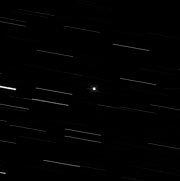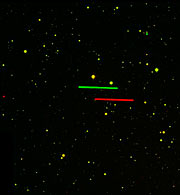Comunicato Stampa
ESO Views of Earth-Approaching Asteroid Toutatis
Unique Photos from La Silla and Paranal Measure the Distance
29 Settembre 2004
Today, September 29, 2004, is undisputedly the Day of Toutatis, the famous "doomsday" asteroid. Not since the year 1353 did this impressive "space rock" pass so close by the Earth as it does today. Visible as a fast-moving faint point of light in the southern skies, it approaches the Earth to within 1,550,000 km, or just four times the distance of the Moon.
Closely watched by astronomers since its discovery in January 1989, this asteroid has been found to move in an orbit that brings it close to the Earth at regular intervals, about once every four years. This happened in 1992, 1996, 2000 and now again in 2004.
Radar observations during these passages have shown that Toutatis has an elongated shape, measuring about 4.6 x 2.4 x 1.9 km. It tumbles slowly through space, with a rotation period of 5.4 days.
The above images of Toutatis were taken with the ESO Very Large Telescope (during a technical test) in the evening of September 28. They were obtained just over 12 hours before the closest approach that happens today at about 15:40 hrs Central European Summer Time (CEST), or 13:40 hrs Universal Time (UT). At the time of these observations, Toutatis was about 1,640,000 km from the Earth, moving with a speed of about 11 km/sec relative to our planet.
They show the asteroid as a fast-moving object of magnitude 10, about 40 times fainter than what can be perceived with the unaided, dark-adapted eye. They also prove that Toutatis is right on track, following exactly the predicted trajectory in space and passing the Earth at a safe distance, as foreseen.
Detailed calculations, taking into account all available observations of this celestial body, have shown that although Toutatis passes regularly near the Earth, today's passage is the closest one for quite some time, at least until the year 2562. The ESO observations, obtained at a moment when Toutatis was very close to the Earth, will help to further refine the orbital calculations.
The "parallax effect" demonstrated!
Simultaneous images obtained with telescopes at ESO's two observatories at La Silla and Paranal demonstrate the closeness of Toutatis to the Earth. As can be seen on the unique image that combines two of the exposures from the two observatories, the sighting angle to Toutatis from the two observatories, 513 km km apart, is quite different. Astronomers refer to this effect as the "parallax". The closer the object is, the larger is the effect, i.e., the larger will be the shift of the line-of-sight.
Interestingly, the measured angular distance in the sky of the beginnings (or the ends) of the two trails (about 40 arcsec), together with the known distance between the two observatories and the position of Toutatis in the sky at the moment of the exposures fully define the triangle "Paranal-Toutatis-La Silla" and thus allow to calculate the exact distance to the asteroid.
It is found to be very close to that predicted from the asteroid's position in its orbit and that of the Earth at the moment of this unique observation, 1,607,900 km. This exceptional, simultaneous set of observations thus provides an independent measurement of Toutatis' distance in space and, like the measured positions, a confirmation of its computed orbit.
More information about Toutatis is available at the dedicated webpage by the French discoverers and also at the specialised Near-Earth Objects - Dynamic Site.
Sul Comunicato Stampa
| Comunicato Stampa N": | eso0430 |
| Legacy ID: | Photo 28a-e/04 |
| Nome: | 4179 Toutatis |
| Tipo: | Solar System : Interplanetary Body : Asteroid |
| Facility: | Very Large Telescope |
| Instruments: | FORS1 |
Our use of Cookies
We use cookies that are essential for accessing our websites and using our services. We also use cookies to analyse, measure and improve our websites’ performance, to enable content sharing via social media and to display media content hosted on third-party platforms.
ESO Cookies Policy
The European Organisation for Astronomical Research in the Southern Hemisphere (ESO) is the pre-eminent intergovernmental science and technology organisation in astronomy. It carries out an ambitious programme focused on the design, construction and operation of powerful ground-based observing facilities for astronomy.
This Cookies Policy is intended to provide clarity by outlining the cookies used on the ESO public websites, their functions, the options you have for controlling them, and the ways you can contact us for additional details.
What are cookies?
Cookies are small pieces of data stored on your device by websites you visit. They serve various purposes, such as remembering login credentials and preferences and enhance your browsing experience.
Categories of cookies we use
Essential cookies (always active): These cookies are strictly necessary for the proper functioning of our website. Without these cookies, the website cannot operate correctly, and certain services, such as logging in or accessing secure areas, may not be available; because they are essential for the website’s operation, they cannot be disabled.
Functional Cookies: These cookies enhance your browsing experience by enabling additional features and personalization, such as remembering your preferences and settings. While not strictly necessary for the website to function, they improve usability and convenience; these cookies are only placed if you provide your consent.
Analytics cookies: These cookies collect information about how visitors interact with our website, such as which pages are visited most often and how users navigate the site. This data helps us improve website performance, optimize content, and enhance the user experience; these cookies are only placed if you provide your consent. We use the following analytics cookies.
Matomo Cookies:
This website uses Matomo (formerly Piwik), an open source software which enables the statistical analysis of website visits. Matomo uses cookies (text files) which are saved on your computer and which allow us to analyze how you use our website. The website user information generated by the cookies will only be saved on the servers of our IT Department. We use this information to analyze www.eso.org visits and to prepare reports on website activities. These data will not be disclosed to third parties.
On behalf of ESO, Matomo will use this information for the purpose of evaluating your use of the website, compiling reports on website activity and providing other services relating to website activity and internet usage.
Matomo cookies settings:
Additional Third-party cookies on ESO websites: some of our pages display content from external providers, e.g. YouTube.
Such third-party services are outside of ESO control and may, at any time, change their terms of service, use of cookies, etc.
YouTube: Some videos on the ESO website are embedded from ESO’s official YouTube channel. We have enabled YouTube’s privacy-enhanced mode, meaning that no cookies are set unless the user actively clicks on the video to play it. Additionally, in this mode, YouTube does not store any personally identifiable cookie data for embedded video playbacks. For more details, please refer to YouTube’s embedding videos information page.
Cookies can also be classified based on the following elements.
Regarding the domain, there are:
- First-party cookies, set by the website you are currently visiting. They are stored by the same domain that you are browsing and are used to enhance your experience on that site;
- Third-party cookies, set by a domain other than the one you are currently visiting.
As for their duration, cookies can be:
- Browser-session cookies, which are deleted when the user closes the browser;
- Stored cookies, which stay on the user's device for a predetermined period of time.
How to manage cookies
Cookie settings: You can modify your cookie choices for the ESO webpages at any time by clicking on the link Cookie settings at the bottom of any page.
In your browser: If you wish to delete cookies or instruct your browser to delete or block cookies by default, please visit the help pages of your browser:
Please be aware that if you delete or decline cookies, certain functionalities of our website may be not be available and your browsing experience may be affected.
You can set most browsers to prevent any cookies being placed on your device, but you may then have to manually adjust some preferences every time you visit a site/page. And some services and functionalities may not work properly at all (e.g. profile logging-in, shop check out).
Updates to the ESO Cookies Policy
The ESO Cookies Policy may be subject to future updates, which will be made available on this page.
Additional information
For any queries related to cookies, please contact: pdprATesoDOTorg.
As ESO public webpages are managed by our Department of Communication, your questions will be dealt with the support of the said Department.





